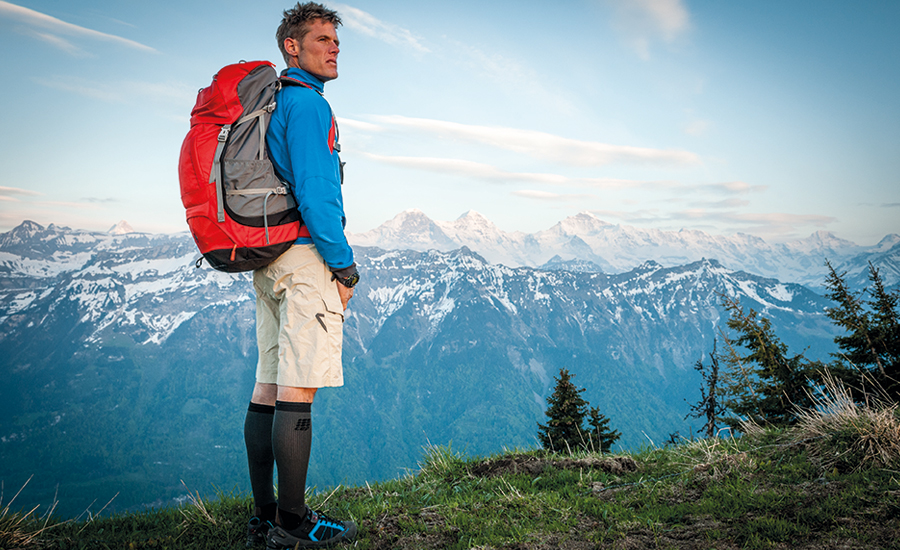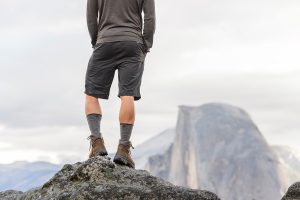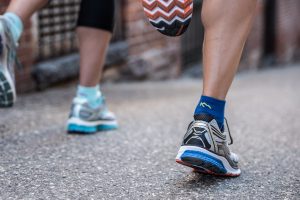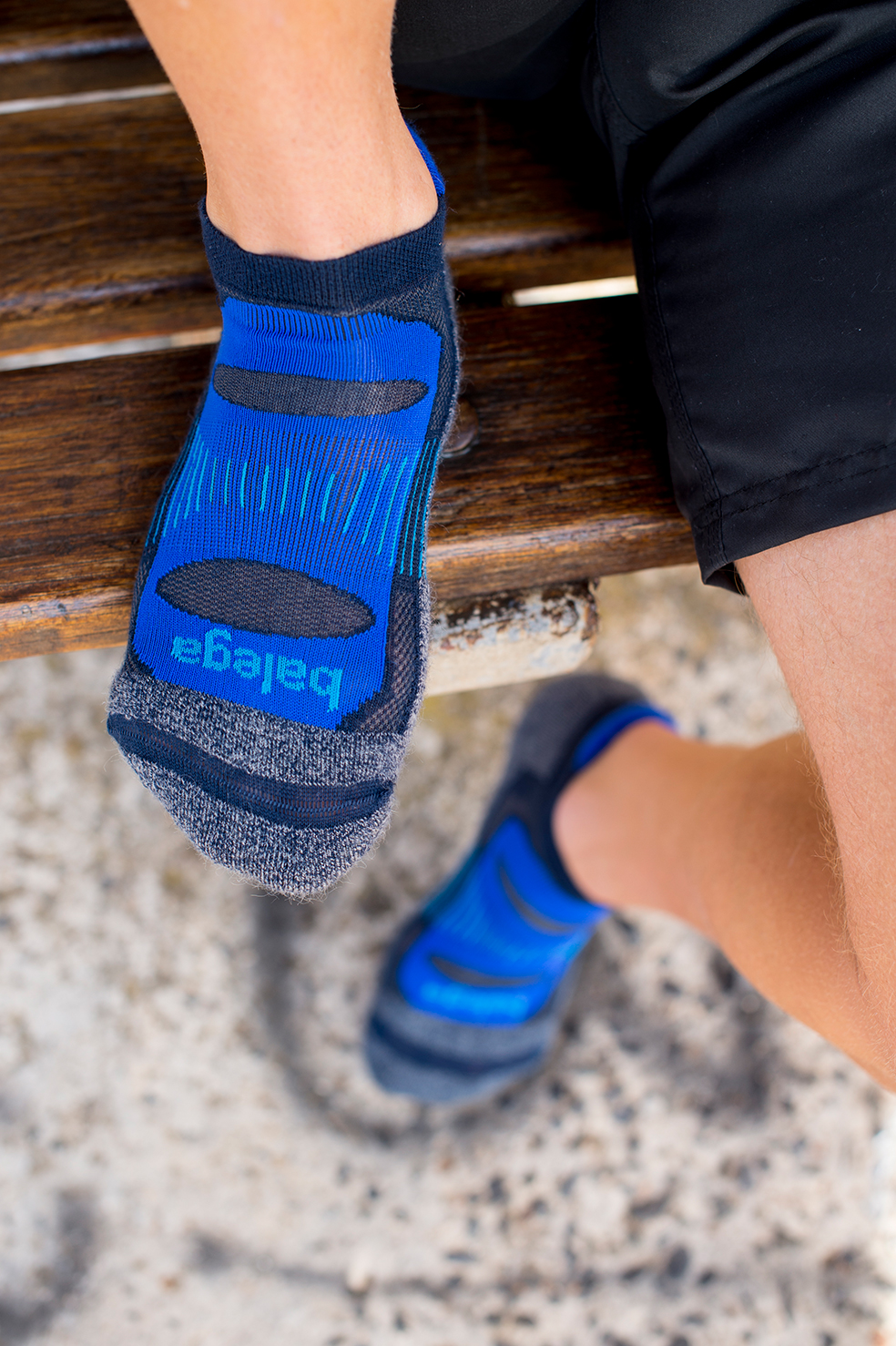Socks Get Tighter and Hipper

Contoured and durable fits, higher needle-counts and good-looking style hit the sock drawer.
Sock brands are tightening up designs for awesome contour fit and compression, as well as introducing styles that bring performance with personality.
Thank runners and bikers who are demanding high-tech hosiery to accompany their hi-tech footwear.
The thin and tight socks bump up feel and support during activity and are at the forefront of what today’s new sock-making machinery can churn out. Companies are excited about finer knits, yet also better durability that can hold up against abuse.
We spoke with several leaders in the sock space to get the full rundown on the most up-to-date tech and consumer trends.
Performance and Personality
A trickle-down of a broader apparel trend, socks are experiencing crossover use. In everyday settings, like a walk to the park or playground, consumers reach for a pair of running or hiking socks that they love for their comfort and durability.
“We designed the Hidden Comfort as a running sock, but once people get into the sock, they wear it for everything: tennis, golf, the gym, etc.,” said Tanya Pictor, vice president, marketing-specialty for Balega. The brand was one of the first to oppose thick, bulky sock design when it entered the market in 2003, she explained.
At the same time, people want to show off their own style while also being comfortable, so it’s increasingly important for functional socks to integrate fun elements of fashion, and vice versa.
“People want to show off their individual style. People are wearing cut-off jeans — like the boot-cut height — or are cupping them to show off individual style.” said Peter Kearns, performance merchandising director for Smartwool. “They want to show off their own subtle personality, which you see in a casual environment.”
Breaking down the barrier of the technical look with fashion can also draw in customers that may not be solely attracted to a high-end performance sock.
“Next year, we’re launching more products that are in the lower price point to capture average customers and have it appealing from a look standpoint, not just performance. Not everyone wants to wear knee-high socks,” said Michael Potter, North American Director of CEP.
To help encourage the crossover sales, CEP will remove the word “compression” from the packaging, Potter explained: “The word ‘compression’ on the package pigeonholes the product.
It’s a psychological thing. People might think the sock is too high-end, or think ‘I’m not injured,’ and then not buy the sock.”
24/7
Hour-to-hour, how do consumers spend each day? For what duration do they actually wear a certain type of sock? Darn Tough Vermont wanted to maximize the potential of consumers pulling on their brand’s designs, so they tackled the question head on, explained Lyn Feinson, director of design and development.
Feinson researched exactly where people were spending their time in a 24-hour period. Running and biking were two of the most widely participated activities, she pointed out in reference to surveys conducted by the Outdoor Industry Association (OIA.) People might bike or run for two hours a day, and then sleep for eight hours. That leaves 14 hours of general ‘life’ — work, school, going out on the town, etc.
-

-
Photo coutesy Smartwool and Fred Marmasterp
-

-
Photo courtesy Darn Tough Vermont
Feinson found that, in general, people are drawn more toward lighter weight yarns for workout sessions. The brand launched a lightweight run collection in spring 2016 called the Vertex Running Series. In its first year on the market, the popularity of the design contributed to an 80 percent increase of total sales in the brand’s endurance/running category compared to the former year’s sales marks in January 2015.
Looking ahead to 2017, Darn Tough took the DNA of the run collection and created a new bike lineup for road cyclists using the same ultralight yarn, close-to-body fit and fine knit upper.
The new bike category “has a really nice, sexy fit and feels great, like you’re wearing nothing. It’s ultralight and ultra thin for road biking, because cyclists require very little between shoes and foot. We also have maximum ventilation, which helps with hot foot, and we designed the height to be around the height of a cyclist’s shoe,” described Feinson. Also for Darn Tough, the brand addressed the other 14 hours of of the day by adding a lightweight, durable line of men’s lifestyle socks in the Elemental series.
Compression, Contour and Comfort
Not only compression but contoured fits are attracting customers.
Balega has steered away from using the term “compression” to describe a “contoured” fit — also achieved with elastic, but with more focus on the structure of the sock matching the foot than an overly tight fit, Pictor said. Comparatively, medical-grade graduated compression socks have an application for recovery and helps to aid muscle fatigue, she said.
Also focused on a performance fit, Smartwool launched its latest PhD performance sock collection — including a run pair — with a super-light knit that is constructed using a 200-needle-count machine.
To knit a pair on a 200-needle-count machine, explained Kerry Nester, president of Farm to Feet, requires a longer run time and costs more, but it’s worth it. (For consumers, the cost difference exists but isn’t standout. For instance, the Damascus was knit on a 200-needle-count and retails for $23. Comparatively, the same product on a 144-needle-count would retail for $20.)
Nester is excited to be using the machine, now, for application in outdoor performance socks. The machine uses a finer yarn with a lower micron — a 19.5 micron versus a 22 micron on the other knitting machines, he said. The result is a softer, more durable and more luxurious sock. Furthermore, the machine “allows for very intricate stitches, detailed logos and graphics, and select cushioning serving any purpose that you see necessary,” Nester said.
Lead photo courtesy CEP


